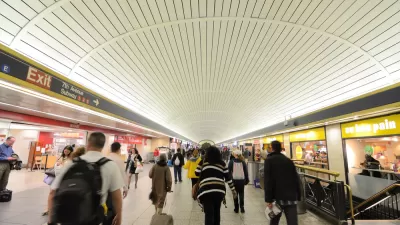Similar to high-speed rail projects throughout the nation, Amtrak will be looking to the private sector to help pay a portion of the expected $20 billion tab to build two new tunnels under the Hudson River and expand New York's Penn Station.
The project "certainly seems to lend itself to some aspect of public-private partnership involvement, particularly in station development," said Drew Galloway, Amtrak's deputy chief of Northeast Corridor Planning and Performance, about the plan known as Gateway Program, write Hilary Russ and Edward Krudy for Reuters.
Private financing would be especially suited to the expansion and revamp of New York's Penn Station, but could also help fund tunnel construction itself, said Galloway
The Gateway Development Corporation, which will be housed within the Port Authority of New York and New Jersey, will be in charge of the project. Amtrak and the U.S. Department of Transportation will pay half the cost, and New York and New Jersey will pay the other half.
The Port Authority is already using public-private partnerships for a $4 billion LaGuardia Airport upgrade and a $1.5 billion revamp of (the Goethals Bridge) linking Staten Island to New Jersey.
According to the Reuters' graphic, the Gateway Program would be the third "largest in the United States using a combination of private and public money" after California high-speed rail and California's Bay Delta Conservation Plan.
Private funding is possible when there is a revenue component to the project, such as toll roads and bridges. "A surcharge on commuter tickets, tolls for freight traffic or facility maintenance payments are possible ways for private sector players to earn back their investments, analysts said," add Russ and Krudy
In other rail projects, private funds are expected to foot most, if not all of the cost of the:
- DesertXpress high-speed rail from Victorville, Calf. to Las Vegas
- Texas Central Railway (high-speed rail from Dallas to Houston)
- All Aboard Florida (125 mph rail from Miami to Orlando)
- Northeast Maglev from Washington to Baltimore
FULL STORY: Tight budgets open $20 billion New York tunnel plan to private cash

Maui's Vacation Rental Debate Turns Ugly
Verbal attacks, misinformation campaigns and fistfights plague a high-stakes debate to convert thousands of vacation rentals into long-term housing.

Planetizen Federal Action Tracker
A weekly monitor of how Trump’s orders and actions are impacting planners and planning in America.

Chicago’s Ghost Rails
Just beneath the surface of the modern city lie the remnants of its expansive early 20th-century streetcar system.

Bend, Oregon Zoning Reforms Prioritize Small-Scale Housing
The city altered its zoning code to allow multi-family housing and eliminated parking mandates citywide.

Amtrak Cutting Jobs, Funding to High-Speed Rail
The agency plans to cut 10 percent of its workforce and has confirmed it will not fund new high-speed rail projects.

LA Denies Basic Services to Unhoused Residents
The city has repeatedly failed to respond to requests for trash pickup at encampment sites, and eliminated a program that provided mobile showers and toilets.
Urban Design for Planners 1: Software Tools
This six-course series explores essential urban design concepts using open source software and equips planners with the tools they need to participate fully in the urban design process.
Planning for Universal Design
Learn the tools for implementing Universal Design in planning regulations.
planning NEXT
Appalachian Highlands Housing Partners
Mpact (founded as Rail~Volution)
City of Camden Redevelopment Agency
City of Astoria
City of Portland
City of Laramie



























